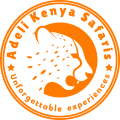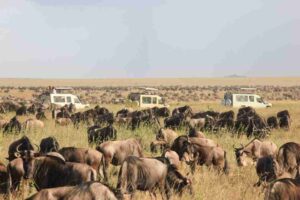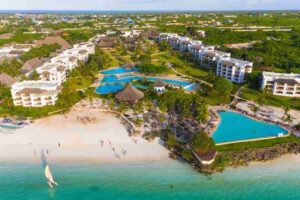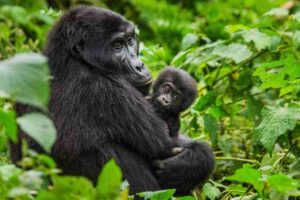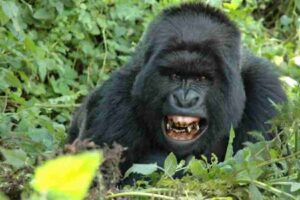| Name of the facility | Exploreans Mara Rianta Camp |
|---|---|
| Certification Achieved | Silver |
| Year opened | 2011 |
| Tourism region | Masai Mara/South Rift |
| County | Narok |
| Address | Narok Map It |
| Telephone/Mobile | Tel: + 254 788 262 666 |
| [email protected] | |
| Website | exploreans.com |
| Facility Notes | Exploreans Mara Rianta Camp is located in Mara North Conservancy situated within the Mara-Serengeti Ecosystem. The camp was established in 2011 and is managed by Neptune Hotels. It has twenty (20) tents with a maximum bed capacity of 46. The camp is open all year round and has 49 permanent staff for its operations. It is designed to have a low impact on the environment. The canvas tents are beige in color, and blend in with the natural surroundings. They are raised from the ground on wooden platforms, leaving the natural vegetation relatively undisturbed.
Mara North Conservancy covers an area of approximately 74000 acres (30,000 hectares) of land, bordering Masai Mara National Reserve to the north therefore forming a critical part of the Masai Mara ecosystem. The conservancy is a partnership between 12 member camps (tourism operators) and over 800 land owners; where land has been leased from individual Masai land owners. The aim of this conservancy is to create a best practice, world class conservancy with long term commitment to the environment, wildlife and local communities. The conservancy supports the one bed per 700 acres policy so as to minimize impact on the environment. It is managed by a board of directors elected by the camp owners, which works in partnership with Masai Land Owners Committee to meet long and short term conservation objectives for the future. Together the conservancy and the Masai community are implementing sound land management policies which include; controlled grazing, holistic management practices, low volume and low impact tourism and community land use plans. Common wildlife within the conservancy include zebra, Thompson’s gazelle, impala, elephants, hyenas, wild dogs as well as big cats-lions, cheetah and leopards. The conservancy is also a haven for birdlife. |
| Energy management | The main source of power at the camp is solar fixed with power inverter battery system. The energy is used for lighting and running electrical appliances. Back-up power is provided by two generators with an output of 100KvA and 250Kva respectively which are only used for running the cold room and freezers. Diesel consumption for the generator is well monitored. Water heating for the camp is conducted through solar water heaters. The camp has (26) twenty six solar heaters with a capacity of 300 litres each. Liquefied Petroleum gas (LPG) is used for guests cooking. The staff is sensitized on energy conservation through departmental briefings whereas visitors are sensitized on arrival briefings. Also, guest tents are fitted with room information sensitizing visitors on energy conservation. The guest tents are fixed with main switches and the night guards are sensitized to switch off unnecessary lights. Also, Energy saving bulbs is installed throughout for energy conservation |
| Environmental management | Exploreans Mara Rainta has an environmental policy that guides the camp operations. |
| Chemical use | The camp uses biodegradable shower and laundry soaps and chemicals. Fuel (diesel) is stored in a tank with a capacity of 4000 liters. |
| Conservation Criteria | |
| Community Criteria | |
| Solid waste management | Waste separation at the facility is conducted at source. The bins are colour coded and the staff sensitized on waste separation and management at source. The waste is put in holding area for further sorting before disposal via Neptune Hotels and Aitong for recycling. Organic waste is composted in a compost pit which is well secured and fitted with a cage to keep off scavengers. |
| Water management | Main source of water for the camp is obtained from a borehole within the premises. The water is solar pumped and collected in a reservoir with a capacity of 60,000 liters and two feeder tanks of 10,000 liters each. It then flows via gravity to the entire facility. The water is metered at the extraction point and recording done on a regular basis for monitoring purposes. The camp has installed a reverse osmosis water treatment/filtration plant for purifying drinking water. This has reduced on need to buy bottled water consequently reducing on plastic waste generation. Other initiatives aimed at efficient water use include; installing low shower filter heads and lift taps to reduce and monitor water use and dual flush toilet cisterns in the guest tents to reduce on the amount of water consumed per flush. Guests are sensitized on water conservation efforts by the camp manager upon arrival and through tent information folders. There are also “towel talk” signs in the guest tents encouraging guests to re-use their towels to reduce on water usage. |
| Visitor communication & education | Exploreans Mara Rianta Camp has a visitors’ resource area (located at the main tent) equipped with reading materials including environmental publications, wildlife and travel magazines, and nature conservation magazines such as Africa Geographic, Books on Kenya, Birds of Kenya. Mammals and bird list to sensitize visitors on the environmental values, and conservancy operations and activities. Guests are briefed upon arrival on the values of the camp, camp operations and the Conservancy while booklets and room information folders are available at the resource information section and guest tents respectively. Trees planted within the camp and guest tents have local names included |
| Pollution | Low wattage bulbs are used to light the pathways at night which greatly reduces light pollution while the fuel store is well enclosed in a concrete area to contain spills. |
| Environmental conservation | Exploreans Mara Rianta is built to have a low environmental footprint and blends in with the local surrounding. The guest tents are made of beige canvas raised on wooden platforms and the surrounding indigenous vegetation is left intact. The camp encourages tree planting for guests and staff all-round the facility aimed at promoting environmental conservation. The camp is located within Mara North Conservancy and plays a significant role in the conservancy operations by paying monthly conservancy and bed night fees. It assists the conservancy rangers in wildlife monitoring and report on any incidences to the conservancy. Occasionally, the facility hosts a research team from the conservancy who give lectures to guests on conservation and wildlife monitoring issues within the conservancy to create awareness. |
| Waste water management | Effluent from the guest kitchen flows through a grease trap to filter out oils and grease before draining into a three compartment septic tank. Effluent from the guest tents and staff quarters is managed through the septic tank. The facility has a swimming pool which is cleaned via vacuum cleaning and backwash systems and water pumped back to the pool. PH and chlorine levels are checked daily. Backwash is done once a week depending on guest occupancy. Black water within the facility, guest area, public areas and staff quarters is managed through a septic tank system. Biological enzymes are added to enhance sludge digestion. Effluent undergoes different stages of treatment and ends up in a nearby soak pit filled with coarse rocks and gravel to enhance the effluent filtration. |
| Purchasing and supplies | Staff food is bought in bulk to reduce on packaging while guest food is purchased on demand. Fruits and vegetables are packed in re-usable crates whereas meat is stored in a cold room. Some fresh vegetables are picked from the vegetable garden reducing the need for packaging. |
| Employment and remuneration/staff welfare | There is a staff welfare committee which handles and addresses staff issues to the management. The employees are registered under KUDHEIHA (Kenya Union of Domestic, Hotels, Education Institutions, Hospitals and Allied Workers). |
| Staff education, communication and awareness training | The camp has notice boards fixed within for staff communication while further sensitization is done through departmental briefings/meetings. |
| Cultural preservation and promotion/protection of local sites | The facility offers village visits to guests for cultural experiences, where they are sensitized on the local Maasai culture. Guests are charged $25 per person for the visits which directly goes to the community. The guides at the camp are from the local Masai community who act as interpreters and expound on the local culture to the visitors. During high season, students from the local primary school (Mara Rianta) are invited to entertain guests through cultural dances. |
| Benefits to local community/community empowerment | The camp purchases from the locals where possible. Products such as beads and meat for staff, is obtained locally. Also, the facility employs from the local community. Approximately 50% of the staff are from the local Masai community. The conservancy pools together the bed night fees, leases fees and conservancy fees which are paid for conservancy management and operations, and specifically to individual land owners. Major projects such as education, healthcare and community development are implemented through conservancy initiatives. The camp supports a local community women group by providing space to sell their cultural artifacts and curios directly to guests on demand basis. The women also have the chance to teach beadwork to the guests. Further, the facility through guest contributions support Mara Rianta primary school through donations such as text books, shoes, stationery and sports equipment. Staff benefits include food, medical cover, uniform, entertainment, transport and accommodation. |
| Cultural Criteria | |
| Health and safety | The camp has a core team of staff trained on Occupational Health and Safety. In addition it has an occupational health and safety team as required by Legal Notice No 31 of 2004. There is a clinic within the camp and a clinical officer who comes thrice a week. Medical emergencies are referred to Mara Rianta. In addition, the facility is subscribed to AMREF Flying doctors for Emergency services. The camp provides a medical cover for staff. Medical check-ups have been conducted for food and beverage handlers dated October 2014- to ascertain their health fitness in compliance with Food, Drugs, and Chemical substances Act. Cap 254. The camp has a team of staff trained on first aid and fire-fighting skills. A first aid kit is available at the camp clinic. Guest tents are provided with torches and an electric switch for emergency response. There are folders for guests with information on safety while at the facility and emergency contacts. Safety and precautionary signage has been installed at the fuel storage area, workshop and generator room for safety purposes The facility has conducted a health and safety audit in compliance with section 11 of Occupational Safety and Health Act 2007. Fire assembly points are properly marked and displayed within the camp. Staff are also provided with PPE (Personal Protective Equipment) such as overall, gloves and boots. |
| Child labor, abuse and human rights | The facility does not employ any person below the legal working age of 18 year |
| Business Practises Criteria | |
| Entry Date | 12th March 2018 |
Exploreans Mara Rianta Camp
Book best Africa Luxury Safaris in Kenya & East Africa explore best wildlife parks,, wildebeest migration, big five, big cats, cultures, beaches & natural wonders
Table of Contents
Why Go with Adeli Kenya Safaris
- Born, raised & based in Africa. Let u show you the Africa we know well and cherish so much
- Africa sustainable travel is our passion
- Great Value for Money. Best price guaranteed
- Experienced team of travel experts
- Knowledgeable & multi-lingual safari guides
- Safety conscious
- Fleet of well maintained vehicles
Your dream safari / holiday is just a call or email away. Contact Adeli Kenya Safaris today. Tel: +254720564538 | WhatsApp: +254720564538 | Email: [email protected]
